I'm looking for a way in vim to easily visualize the various indent levels of python code. It would help if there was always a vertical rule at the beginning of the current line. That way I can scan down the code to see where the current block ends. Are there any plugins out there that do this?
5 Answers
You could simply emulate indentation guides. It's simpler and more effective, in my opinion. Please, take a look at my answer to the question about indentation guides.
The first thing that comes to mind is that you could benefit from a plugin that implements code folding.
Here is a tutorial with examples (scroll down to "Code folding") that recommends the use of the "Efficient python folding" plugin for vim.

(source: dancingpenguinsoflight.com)
- 21,988
- 13
- 81
- 109
- 33,067
- 9
- 68
- 86
in vim (no plugins needed):
:set list
will display tabs as '^I' and EOL as '$' by default.
with
:set lcs=tab:>>
you'd set '^I' to '>' (see more on that by :help listchars).
i'm not sure, but there should be another option to set the tab width.
also you may set
:set autoindent
for python
- 57
- 1
- 3
-
It is recommended to indent Python with 4 spaces, not with tabs. – ZyX Aug 27 '10 at 21:56
-
@abhijit: you can accomplish what ZyX mentioned by: :set shiftwidth=4 :set autoindent use CTRL+T in insert mode – mathume Aug 27 '10 at 22:12
-
1This was about the fact that most of Python code is indented with spaces, so setting `list` and `lcs` will not show anything. And `expandtab` is maybe better for python. – ZyX Aug 27 '10 at 22:20
I think the command you're looking for is "colorcolumn", it's new to vim 7.2 or 7.3 I think.
You might be able to work something up with the autocommand trigger CursorMoved
autocmd CursorMovedI * set colorcolumn=match(getline("."),"\S")
You will probably have to play with this, using intermediate variables and such.
What this would do (if properly buried inside a function), is put a single vertical line at the starting character of the current line. This might be handy, but should probably only be put on a toggle.
EDIT: This turns out to be a bit more complicated than I thought originally. Basically you have to eliminate the effect of literal tabs (if they show up in your file)
autocmd CursorMoved * let &colorcolumn=matchend(substitute(getline("."),'\t',repeat(" ",&ts),'g'),"\\S")
When I was first putting this together I sortof thought it was silly, but just playing around with it for a few minutes, I sortof like the effect.
Note that you may or may not want a CursorMovedI version.
- 16,497
- 3
- 46
- 59
-
2You have at least two errors: 1. replace `set colorcolumn` with `let &colorcolumn`: `set` command does not evaluate expressions. 2. Escape backslash in the second argument of match() (or replace double quotes with single). – ZyX Aug 27 '10 at 22:17
You can define you own syntax items for it (or use matches). Quick and dirty solution:
let colors=["red", "white", "yellow", "green", "blue"]
let matchids=[]
for level in range(1, len(colors))
execute "hi IndentLevel".level." ctermbg=".colors[level-1]." guibg=".colors[level-1]
call add(matchids, matchadd('IndentLevel'.level, '^ '.repeat(' ', level-1).'\zs '))
endfor
This will highlight five first indentation levels with different colors.
To disable:
while !empty(matchids)
call matchdelete(remove(matchids, 0))
endwhile
- 52,536
- 7
- 114
- 135